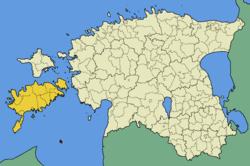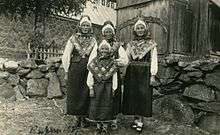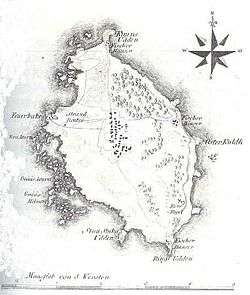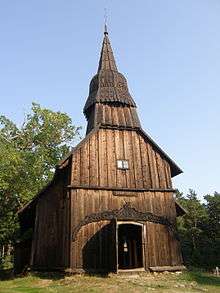Ruhnu
| Ruhnu Parish Ruhnu vald | |||
|---|---|---|---|
| Municipality of Estonia | |||
| |||
 Ruhnu Parish within Saare County. | |||
| Country | Estonia | ||
| County | Saare County | ||
| Administrative centre | Ruhnu village | ||
| Government | |||
| • Mayor | Jaan Urvet | ||
| Area | |||
| • Total | 11.9 km2 (4.6 sq mi) | ||
| Population (01.01.2015) | |||
| • Total | 97 | ||
| • Density | 8.2/km2 (21/sq mi) | ||
| Website |
ruhnu | ||
Ruhnu (Swedish: Runö; Latvian: Roņu sala) is an Estonian island in the Gulf of Riga in the Baltic Sea. It is administratively part of Saare County but is geographically closer to the Latvian mainland. At 11.9 square kilometres (4.6 sq mi), it has currently fewer than 100, mostly ethnic Estonian, permanent inhabitants. Before 1944, it was for centuries populated by ethnic Swedes and traditional Swedish law was used.
Geologically the island is the higher part of a submarine drumlin-like ridge.[1]
History


The first archaeological artifacts of human activity in Ruhnu, assumed to be related to seasonal seal hunting, date back to around 5000 BC. The time of arrival of the first ancient Scandinavians in Ruhnu and the beginning of a permanent Swedish-speaking settlement is not known. It probably did not precede the Northern Crusades in the beginning of the 13th century, when the indigenous peoples of all the lands surrounding the Gulf of Riga were converted to Christianity and subjugated to the Teutonic Order. The first documented record of the island of Ruhnu, and of its Swedish population, is a 1341 letter sent by the Bishop of Courland which confirmed the islanders' right to reside and manage their property in accordance with Swedish law.
Ruhnu was controlled by the Kingdom of Sweden (1621–1708, formally until 1721) and after that by Imperial Russia until World War I, when it was occupied by Imperial Germany (1915–1918). After the war, despite some local initiatives to rejoin Sweden, and territorial claims by Latvia, the islanders agreed to become part of newly independent Estonia in 1919 (possibly due to the existence of a Swedish minority in Estonia).[2] According to a census taken in 1934, Ruhnu had a population of 282: 277 ethnic Swedes and 5 ethnic Estonians.
During World War II, Ruhnu, along with the rest of Estonia, was occupied first by the Soviet Union (1940–1941) and then Nazi Germany (1941–1944). In November 1943, a first group of about 75 islanders relocated to Sweden. In August 1944, shortly before the Soviet Union reoccupied Estonia, the remaining population of the island, except two families, fled by ship to Sweden.
During the period of Soviet occupation after 1944, the island was repopulated by Estonian civilians and also served as a basis of a small Soviet military garrison. The number of inhabitants never exceeded 400, and in the 1970s, after a storm hit Ruhnu, most people were relocated.
Life on Ruhnu today

After Estonia regained its independence in 1991, buildings, land, and other property on Ruhnu Island were returned to those with ownership claims that went back to before to the Soviet occupation of Estonia, or to their descendants. In case of Ruhnu, those descendants were mostly resident in Sweden. Most of them did not return to Ruhnu, but they still occasionally visit the land of their forefathers.
Ruhnu is served by the Ruhnu Airfield which has weekly flights from Pärnu and Kuressaare in winter, twice weekly in summer, and by ferry service.
The island has a quadripod tower lighthouse, which stands on the highest point of the island, Haubjerre hill. It was prefabricated in France and shipped to Ruhnu for assembly in 1877. The structure was designed by Gustave Eiffel.
The Ruhnu wooden church, built in 1644, is one of the oldest wood constructed buildings in Estonia. The church's baroque-style tower was finished in 1755. The stone Lutheran church next to the wooden one was built in 1912 and is currently where services are held.
Limo beach is one of the island's most popular and accessible beaches for tourists.
Ruhnu is home to a rare native breed of sheep called the Estonian Ruhnu (Estonian: eesti maalammas). The breed numbers approximately 33 individuals and are used primarily for wool.[3] A herd of fifty highland cattle were introduced to Ruhnu in 2013, in an attempt to restore the semi-natural coastal meadows in the southwestern part of the island.[4]
In the spring of 2006, a 150-kilogram (330 lb) brown bear arrived on Ruhnu via an ice floe across the Gulf of Riga from the mainland of Latvia, some 40 km (25 mi) away. The bear's journey and resettlement on the island became a highly publicized media sensation in both the Estonian and Latvian press, as Ruhnu has been devoid of any large carnivores for many centuries. The bear continued to evade capture for months and environmental ministry officials reported that tourists hoping to catch a glimpse of the elusive bear outnumbered permanent residents.[5] The bear is believed by authorities to have since returned to Latvia.[6]
In April 2007, Latvian chocolate producer Laima presented Ruhnu islanders with a 40-kilogram (88 lb) chocolate statue of the bear to go on display before being eaten by islanders.[6] This chocolate bear was finally eaten on 20 December 2007.
Further reading
- Karl Friedrich Wilhelm Rußwurm: Eibofolke oder die Schweden an der Küste Esthlands und auf Runö, eine ethnographische Untersuchung mit Urkunden, Tabellen und lithographirten Beilagen. Reval 1855
- There is an account of life on Ruhnu in the 1920s in Arthur Ransome's 1923 book Racundra's First Cruise (republished in 2003 by Fernhurst Books).
- A useful short article on Ruhnu appeared in Hidden Europe Magazine, 15 (July 2007), pp. 20–1.
- Taylor, N. with Karin T (2008). Saaremaa: a History and Travel Guide. Tallinn: OÜ Greif. ISBN 978-9985-3-1606-1, pp 78–83
- (in Swedish) Hedman, Jörgen & Åhlander, Lars. 2006: Runö. Historien om svenskön i Rigabukten. Stockholm: Dialogos, ISBN 91-7504-184-7
See also
References
- ↑ "The islands in the Väinameri Sea and the Gulf of Riga". Estonica. Eesti Instituut. September 28, 2012. Retrieved February 20, 2018.
- ↑ Ķibilds, Mārtiņš (25 May 2018). "Ruhnu rumpus: How the tiny Baltic island came under Estonian control". eng.lsm.lv. LTV. Retrieved 27 May 2018.
- ↑ North Shed: Origin and diversity of North European sheep breeds
- ↑ ERR News: Highland cattle imported to remote island
- ↑ Carnivore Conservation: Elusive bear wanders Ruhnu Island and makes its population double. Friday, June 2, 2006
- 1 2 BBC News: Latvia bears giant chocolate gift. April 6, 2007
External links
- Ruhnu
- DMOZ Ruhnu - A list of English sites about Ruhnu.
- Ruhnu marina.
| Wikimedia Commons has media related to Ruhnu. |
| Wikivoyage has a travel guide for Ruhnu. |

